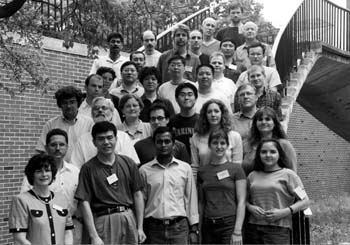 |
|
Picture: Memorial photograph of symposium participants
|
I had an opportunity to attend an international symposium entitled the '14th International Summer Symposium on Science and the World Affairs,' which was held at the University of Illinois in the United States from July 15 to 21, 2002.
The symposium was hosted by the Union of Concerned Scientists (UCS), a U.S.-based non-governmental organization established by American scientists. Since the U.S. was the host country this time, the study program on Arms Control, Disarmament, and International Security at the University of Illinois cooperated in the organization of the symposium.
For the past 30 years, according to the UCS, technically informed specialists have began to play an important role in the policy arena with regard to the issues of international safety assurance and arms control. While such specialists watch the government and industry's activities in such areas, they can also provide basic scientific information to help policymakers arrive at their decisions.
The aim of this symposium was to support young scientists whose research interest is related to international security and arms control. In particular, the organizer urged many scientists to attend whose home country's natural science field has not paid special interest to the issues discussed. Another important purpose of this symposium was to create a network linking researchers working in similar situations. The symposium started in 1989 and has been staged in Russia, the U.S., China, and Germany, with researchers participating from more than 18 countries, including Japan.
This year, about 40 participants attended from 9 countries, most of whom were engineers and physicists working in universities. However, their specialties were not limited to only nuclear engineering but to other specializations such as laser physics and space engineering.
Because it was the first symposium to be held after the last year's September 11th terrorist attacks in the U.S., many presentations concerning nuclear terrorism attracted the audiences' attention. For example, a Chinese researcher calculated the damages that would occur if terrorists launched a small-scale atomic bomb from a ship or a truck. Other researchers, considering the kinds of nuclear weapons terrorists might use, indicated that reactor-grade plutonium could be used for such purposes.
Other than terrorist related nuclear issues, a Russian presenter talked about the capacities for storing spent fuels at a plant named RT-2, whose construction is currently suspended, and the way an operational procedure for securing safety of the plant might be established. In addition, the following risk calculations were performed for each case: an earthquake and strong wind as exterior hazards; a fire as an interior hazard; the treatment of a cask; loss of cooling water; and the loss of electrical power.
A researcher from Germany reported that reactor-grade plutonium could be used to create a nuclear explosion by breeding tritium from a fusion power plant where the pre-ignition problem will be lessened.
I presented on the possibilities of nuclear fusion technologies being applied to the development of nuclear weapons in Japan. Nuclear fusion R&D is said to be conducted only for peaceful purposes. I demonstrated from the engineering point of view, however, that it could be possible for research to be used for military applications. By drawing attention to the Magnetic Confinement Fusion device JT-60 at Japan Atomic Energy Research Institute (JAERI) and the inertial Confinement Fusiondevice Gekko-XII at Osaka University, I argued that we already had both nuclear technologies, such as neutron sources and tritium production technologies, had potential military applications, and there are possibilities to transfer the development of certain other technologies, i.e. laser and beams, in order to utilize them for space weapon military purposes. In the discussion time, many questions were raised regarding Japan's three non-nuclear principles. It seemed that Japan's plutonium stockpile and highly advanced technology posed serious threats to many foreign observers.
Apart from nuclear issues, there were many presentations related to space weapons and technical criticisms of the Bush administration's missile defense strategy.
During the symposium, I used the university's housing and dining rooms, which provided me with the experience of an American college student. During a break, many participants visited an Amish village, which was located around an hour's drive from the university. The Amish have chosen not to participate fully in modern civilization - consuming a very small amount of energy - without any compulsion in their living. In particular, their beautiful houses and attractive dress appealed to many participants. We enjoyed a simple but tasty meal there.
Following the symposium, on the 22nd and 23rd of July, the '1st International Professional Meeting of Independent Technical Security Analysts' was held in Chicago. I had a chance there to meet Dr. Frank Von Hippel, who served as an assistant director of national security at the White House, and is a professor at Princeton University, and Richard L. Garwin, who has experience in developing nuclear weapons and served on the President's Scientific Advisory Committee.
Marvin Miller of the Massachusetts Institute of Technology, made an interesting presentation entitled, 'Japan and Nuclear Weapons, and Reactor-grade Plutonium.' He emphasized the fact that Japan took seven years to ratify the Non-proliferation Treaty (NPT), which appeared to confirm Japan's affirmative stance towards the utilization of nuclear weapons. He concluded that therefore Japan could be regarded as essentially nuclear weapons state in light of the current advanced ability of Japan's science and technology.
Regarding the impression of this symposium it seems to me that it was not wholly satisfactory since there was little discussion about the importance of citizens' participation in this field. Perhaps this was unavoidable because most participants came from universities and research institutions; very few participants from non-governmental organizations at the symposium. There were sometimes situations reflecting complicated national outlooks in which the use of nuclear weapons was justified as a necessary condition to protect the home country. However, all the experiences that I gained during the symposium were very valuable, prompting me to think about how I should work in this field in the future.
Return to NIT 91 contents

